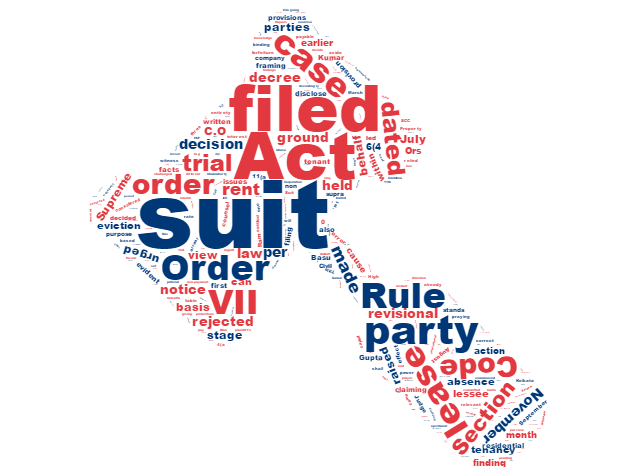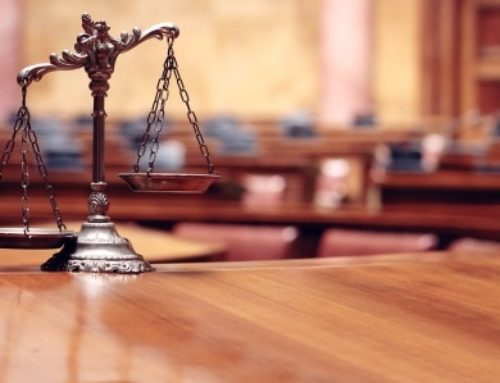Editor’s Note: This post (the first part of a two-part series) is a transcript of a webinar conducted by Justice N. Anand Venkatesh of the Madras High Court on the Structuring of Pleadings under the Civil Procedure Code. The webinar is a part of the Nyaya Forum for Courtroom Lawyering’s Webinar Series on Practical Skills for Litigation. The video of the webinar can be found here. The second part of the transcript can be found here.
Introduction
Imagine that you are sitting in your office. A poor man from a village or a neighbouring district enters, and narrates his problem, asking for your legal help. You start taking information from him. He is not legally trained, and is going to give you all sorts of facts without a clear chronology or sequence. Now, you have to patiently listen to him and ask him the right questions in order to understand all the facts. Then, you have to sequence these facts. That is where pleadings begin. As a lawyer, you collect information from your client, sequence it, collate it, give it a structure and then find whether there is any cause of action for proceeding further. In case a cause of action exists, you seek an appropriate remedy as against the defendant. In this manner, being exposed to pleadings drafting on a regular basis results in a civil lawyer normally being successful in whatever branch he/she subsequently takes. Indeed, civil law is a foundation for a young advocate. Speaking from my personal experience, I (Justice Venkatesh) also started out as a civil lawyer. As I moved up the profession, I found that I was easily able to understand and take up other fields like criminal law, service law, labour law etc. I will talk about pleadings against this backdrop.
Objects and Scope of Pleadings
Pleadings under Order VI Rule 1 of the Code of Civil Procedure (“CPC”) includes two terms – a plaint and a written statement. At the outset, it is important to first understand the objects and scope of pleadings –
- A pleading is meant to give each side an intimation of the case of the other. This means that the plaintiff will have to intimate the defendant what his/her case is, and the defendant has to intimate the plaintiff as to what his/her defense is. This is the basic requirement of a pleading, and is also its primary object.
- A pleading ensures that both sides are fully aligned and aware as to the questions that are likely to arise and be exchanged amongst each other, so that parties can be prepared with the relevant evidence. Thus, pleadings ensure that the parties know about the questions that are likely to arise between them, since each side intimates the other about its respective case.
- A pleading enables the court to determine what really the issue between the parties is. The court, after going through the plaint and the written statement, can understand the real issue to be decided in a given case.
- Once the issues are framed, the pleadings clearly lead to the evidence that has to be led in during the trial. The fundamental law is that evidence which is not supported by a pleading cannot be given at a trial. Hence, pleadings guide the evidence during trial by ensuring that litigants come to trial by being prepared accordingly.
These are the four objects or purposes of pleadings. The judgment of Supreme Court in Bachhaj Nahar vs Nilima Mandal (2008) 17 SCC 491, authored by J. Ravinder (one of the greatest judges on the civil side) beautifully brings out the object and the purpose of the pleadings.
Importance of Pleadings
Various facets about the importance of pleadings can be understood through judicial pronouncements. These facets are: –
- Evidence without a pleading is largely immaterial. Therefore, a party cannot bring in evidence that is not supported by a pleading. Such evidence cannot be looked into or relied upon. In order to understand this better, let us consider a suit for declaration of title, that is, a suit where a plaintiff wants his title in a property to be declared. While structuring the pleadings, the plaintiff needs to trace his title. Now, while tracing his title through pleadings, let us assume that the plaintiff has not specifically dealt with two documents which are material for the purpose of establishing his title to the property – say, a sale deed and a settlement deed. Now, the plaintiff cannot mark these documents and place them as evidence at trial, since they are not in line with the pleadings. In other words, the plaintiff cannot now rely on documents which he has omitted to mention in the pleadings. In order to understand this situation better, refer to the judgment of the Supreme Court in Executive Officer, Arulmigu vs. Chandran & Ors. (2017) 2 CTC 678, where, just like in the above examples, the Court rejected considering two documents as evidence, since they were not in line with pleadings.
- Proof without pleadings is generally irrelevant. This is because proof is based on evidence, which in turn has to be supported by a pleading.
- Relief which is not founded on the pleadings cannot be granted. When lawyers structure the pleadings, they will have to state the material facts and derive the cause of action. Now, the relief is determined based on these two factors. Hence, a relief not founded on such a pleading cannot be granted.
Form and Contents of Pleadings
I will now be dealing with important CPC provisions and other aspects of pleadings –
Material Facts – Order VI Rule 2 of CPC talks about the contents of a pleading, that is, what a plaint must contain and what a written statement must contain. Order VI Rule 2 makes it very clear that a pleading must state the material facts in a concise form. Indeed, the important word that we will have to pick up from Order VI Rule 2 is “material facts.” Material facts are facts determining the plaintiff’s cause of action or the defendant’s defense. In other words, material facts are those facts which must be proved in order to establish the existence of a cause of action or a defense. With respect to these material facts, there are two terms – facta probanda and facta probantia. While facta probanda refers to material facts, facta probantia is the evidence through which material facts are going to be proved. These two terms are distinct. Order VI Rule 2 insists on material facts, which have to be mandatorily stated in the pleadings in a concise manner. In contrast, it is not necessary to also write about the evidence (facta probantia) in the pleadings. In order to understand facta probanda and facta probantia better, refer to the judgment of the Supreme Court in Virendra Nath Gautam v. Satpal Singh & Ors. (2007) 3 SCC 617.
Form of Pleadings – Order VI Rule 3 of the CPC talks about forms of pleadings. It provides that the form of pleadings is available in Appendix A to the CPC, where the structure of various plaints and written statements such as mortgage suits, recovery of money suit, possession suit, injunction suit, declaration suit etc. can be found. These forms provide a broad idea of how a plaint and written statement look like.
Requirement to Mention Particulars in Case of Fraud etc. – Order VI Rule 4 is a very important provision. Adherence to Order VI Rule 4 is mandatory in all cases of misrepresentation, fraud, breach of trust, willful default, undue influence etc. Where any of these allegations are the basis, pleadings must mandatorily contain exact details and other particulars of these allegations, with dates and items if necessary. The reason behind such an insistence made in pleadings of this nature is because all these allegations involve a mental element. Hence, it is not enough if the parties merely say that fraud was committed, or misrepresentation was made or that one of the parties was lured into going through with an agreement through coercion, imposition or undue influence. Only if all the particulars are given, the defendant will be able to know the grounds on which the plaintiff is alleging there is fraud, misrepresentation, undue influence etc. Only when the defendant is aware of these grounds will he be able to effectively reply to such allegations being made. Indeed, it is impossible for the defendant to mount his defense where the plaintiff merely says that fraud, misrepresentation etc. was committed without providing any details. Thus, providing all particulars in the pleadings while alleging fraud, misrepresentation etc. under Order VI Rule 4 is important and mandatory.
When I say “pleading”, it is important to reiterate that I am referring to both a plaint and a written statement. Just like a plaintiff can plead fraud in a plaint (as in the above example), a defendant can also allege fraud in his written statement. Like in the case of the plaintiff, it is not enough for the defendant to merely take this defense and stop there. The defendant is mandated to tell how that that fraud was committed, on what day it happened, and the circumstances under which it happened. Therefore, as per Order VI Rule 4, it is mandatory to provide particulars in pleadings (both the plaint and written statement) in all cases where parties are basing their case on fraud, misrepresentation etc. For more details on this aspect, refer to the Supreme Court judgment in Saradamani Kandappan vs. S. Rajalakshmi & Ors. (2011) 4 CTC 640. At paragraph 40 of this judgment, the Supreme Court has specifically said that fraud must be “specifically pleaded and proved”. Hence, Order VI Rule 4 is a mandatory requirement. Additionally, a general allegation, howsoever strong in language, without the particulars will not be enough and it will not satisfy the requirements of Order VI. Therefore, strong language that is important. Rather, what is important is to provide with the entire particulars wherever either party is basing the case on fraud, misrepresentation etc.
Legal terms not necessary – Overall, in a pleading, it is sufficient if the lawyer makes the necessary averments in the pleadings and establishes them. Thus, sometimes, it is not important to mention particular words. For example, in a suit for specific performance, “readiness” and “willingness” is a sine qua non for a plaintiff to succeed. This means that generally, in the pleading, the plaintiff should assert that he was always ready and willing to perform his part of the contract, but the defendant was not. Such an assertion is a pre-requisite under Section 16 of the Specific Relief Act. Now, let us assume that the words “readiness” and “willingness” are not used. Instead, the plaintiff writes in the plaint that he entered into an agreement with the defendant (say, for the purchase of a flat). In pursuance of this agreement, he provided the defendant with an advance amount, and subsequently, part consideration. Now, despite notice from the plaintiff, the defendant subsequently refused to execute the sale deed for the flat and accept the balance consideration. In this plaint, the words “readiness” and “willingness” are not mentioned. However, the substance of the plaint clearly shows that the steps taken by the plaintiff clearly show his readiness and willingness. Therefore, in such circumstances, the substance of the plaint establishes “readiness” and “willingness”, legal terms are not required.
Striking out of pleadings – Order VI Rule 16 talks about striking out of pleadings. Where pleadings have been filed before a court, and the court finds that they deal with unnecessary, scandalous, frivolous or vexatious things which may prejudice, embarrass or delay the fair trial of the suit, or which in the opinion of the court is an abuse of the process of the Court, the court may strike out those pleadings. Striking out pleadings not the same as throwing out the plaint or written statement altogether.
As lawyers, we should ensure that out pleadings are not affected by Order VI Rule 16. Parties fighting before the court are not friends. In many cases, they hate each other and would want to show anger in pleadings by using strong language, but as lawyers we should taper it. We need to be careful, and never draft scandalous, frivolous or vexatious pleadings even if client wants us to do so, because ultimately, the court will strike it down. Thereafter, your client would want to challenge this act of striking down. The challenge would be pending for another five years, and there will be no progress in the suit. By the time the suit is eventually disposed, both the parties will be older and the anger will have reduced. Keeping this possibility of delay in mind, as a lawyer, you should try to taper down the initial anger and imbalance in the minds of your clients so as to avoid being hit by Order VI Rule 16.
The next Part of this Transcript on Structuring Pleadings can be found here.
Justice N. Anand Venkatesh is a sitting Judge of the Madras High Court. The post has been transcribed and edited by Kanu Garg and Tanvi Apte, who are students of NALSAR University of Law and contributors to the Nyaya Blog.
bento4d situs toto toto togel toto slot toto slot link slot gacor slot thailand slot gacor





